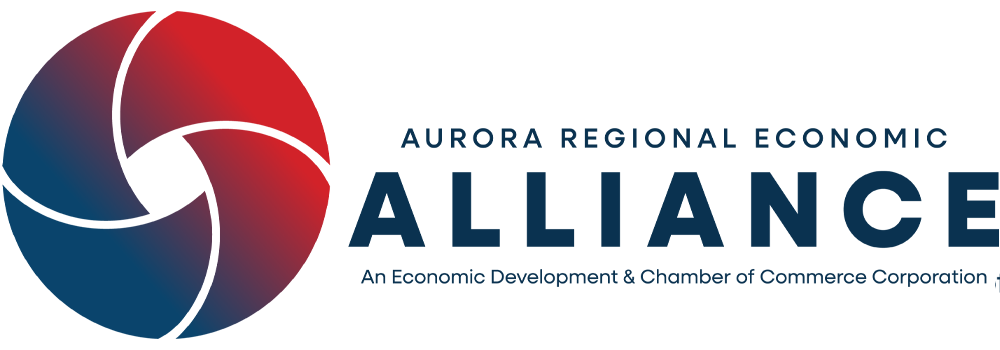Frequently Asked Questions
What is the Alliance?
The Aurora Regional Economic Alliance (Alliance) is a new organization championing the missions of four key civic organizations: the Aurora Regional Chamber of Commerce, Invest Aurora, Aurora Downtown, and the Quad County African American Chamber of Commerce. This consolidation represents a strategic move to create a more powerful and unified approach to economic development in the Aurora region.
What prompted the creation of the Alliance?
Initial discussions about combining efforts started in the fall of 2023, and a committee of organization leaders started meeting in January 2024. A study recommending consolidation was published in June 2024. By fall 2024, the consolidation was approved, and the Alliance officially became operational in January 2025. The formation of the Alliance allows for enhanced regional impact because it promotes a collaborative approach to economic development. By combining efforts, the region will have a stronger, more coordinated voice in advocating for growth and attracting investment.
This new entity ultimately eliminates duplicative functions. Shared resources will allow the Alliance to enhance service delivery for members and target efforts into impactful programs that benefit Aurora businesses and the broader community. An Alliance Board of Directors comprises Board members from the Aurora Regional Chamber of Commerce, Aurora Downtown, Invest Aurora, and the Quad County African American Chamber of Commerce plus representatives from businesses annually pledging $10,000 or more to the Alliance. The Board meets quarterly. An Alliance Executive Committee of 13 members meets monthly. A strategic planning process currently is under way to address both the economic development needs of the region and the organizational requirements for the new Alliance.
What are the key differences between Chamber membership and Alliance membership?
The Alliance will serve as a full-service economic development and business advocacy organization. It will have an expanded portfolio of roles, responsibilities, and programs. The chambers were primarily focused on events, networking, and business education. The Alliance will incorporate those activities into its member services portfolio and also will be responsible for business attraction, retention, and expansion (BRE), investment attraction, talent attraction, business advocacy, data and research, downtown promotion, and the support and education of minority- and women-owned business (MWBEs).
What are the incentives for current Chamber members to transition to the new Alliance model?
Members will benefit from the Alliance’s efforts to diversify and broaden the local commercial tax base through its economic development activities. Combining Chamber efforts will result in a larger, more unified voice for the business community, leading to improved advocacy efforts. The Alliance will add a full-time position responsible for small business advocacy and government outreach. Members also will have expanded opportunities for networking and collaboration.
Shared resources, including staff, will allow for enhanced member services. The Alliance will begin implementing a business attraction, retention, and expansion (BRE) program to support existing employers. The BRE program will include 50–75 personal visits to targeted employers to identify their needs, offer support, and gather market intelligence. The Alliance regularly will track and report on local economic indicators and conditions as well as trends in important local industries. A new emphasis will be placed on marketing for talent attraction and retention to support the growth of the local labor force.
What will the membership tiers and fee structure look like under the Alliance model?
Membership dues will be increased in a phased approach.
- Existing members will see a small increase in 2025 renewals. Dues will range from a minimum of $500 to $25,000 or more.
- In 2026, a uniform dues and benefits structure will be in place for all members.
The rise in dues will support the Alliance’s initiatives and increase in staffing needs to support the expanded suite of member services.
How will my member benefits change?
The region’s mission and vision, as well as the Alliance’s value proposition, will be determined during the strategic planning process. This ultimately will provide the framework for the organization’s programs, services, and events.
The following programs, services, and legacy events will not change:
- Leadership Academy
- LeadHER
- SSA-1 programing, including First Fridays
- Golf outing
- Local business grants and loans
- Monthly networking
We are in the process of merging and updating the membership database. All members will have access to the expanded database later in 2025.
How can I get more involved with Alliance?
There will be numerous opportunities for involvement through:
- Committee participation
- Leadership roles
- Special initiatives
- Community projects
- Networking events
- Professional development programs
How will I be informed of any changes related to my member benefits?
Members will be kept informed throughout this transitional period. A new website will be created and launched in Q4 2025, and a landing page was published in January 2025 detailing important information about Alliance events, news, staff, and Board leaders. In addition, the Alliance will keep you updated by email, social, newsletters, and meetings.
If you have any questions regarding your member benefits, please contact Claire Wozniewski This email address is being protected from spambots. You need JavaScript enabled to view it..
How will Alliance support the broader Aurora community?
Alliance is committed to building a prosperous, resilient community through:
- Economic development initiatives
- Workforce development programs
- Support for diverse businesses
- Innovation and entrepreneurship promotion
- Strategic partnerships
- Community engagement projects
Where can I get more information?
A new website is being designed and will be completed later in 2025. In the meantime, please email and questions to This email address is being protected from spambots. You need JavaScript enabled to view it. and a member of the team will respond.

600+

119

5-Star

 Future Industry Readiness: Creating strategies to position Aurora for success with the industries building the economy of tomorrow that include quantum computing and artificial intelligence
Future Industry Readiness: Creating strategies to position Aurora for success with the industries building the economy of tomorrow that include quantum computing and artificial intelligence Talent Alignment: Preparing recommendations for the Alliance as it relates to the talent needed to accomplish the goals and objectives set forth in the strategic plan
Talent Alignment: Preparing recommendations for the Alliance as it relates to the talent needed to accomplish the goals and objectives set forth in the strategic plan